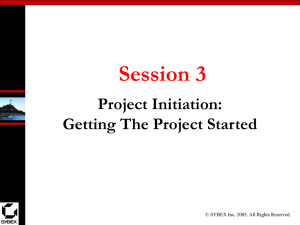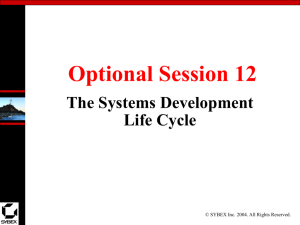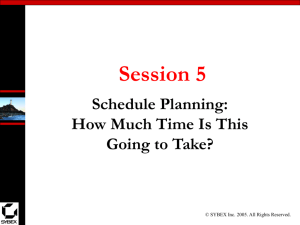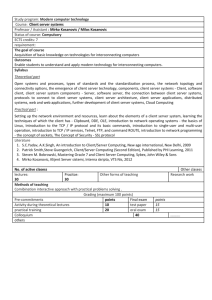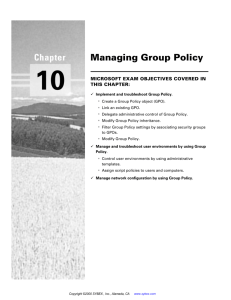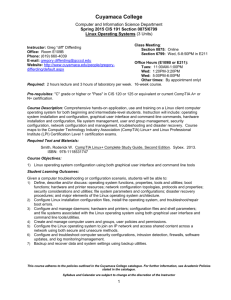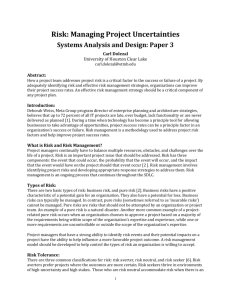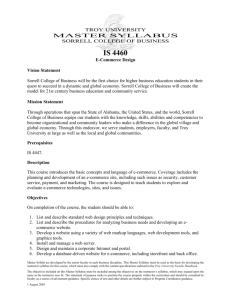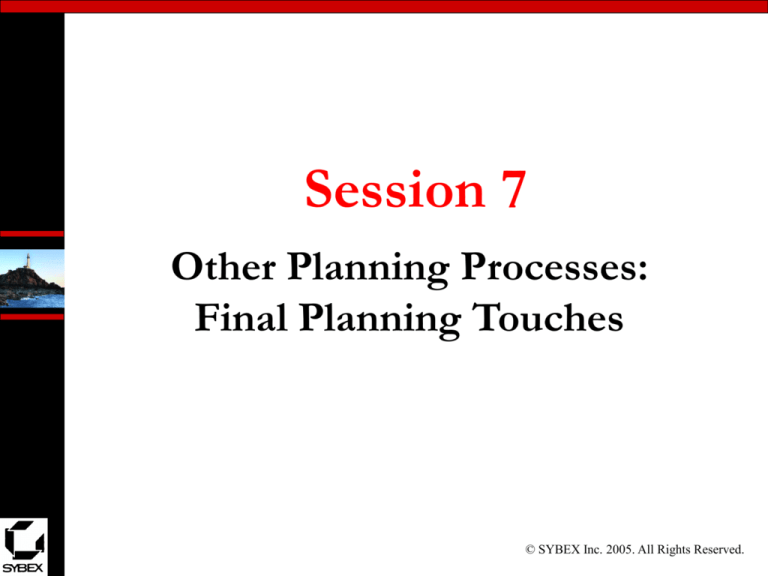
Session 7
Other Planning Processes:
Final Planning Touches
© SYBEX Inc. 2005. All Rights Reserved.
Learning Objectives
• Understand human resource planning
• Understand quality planning
• Understand risk identification and development
of mitigation strategies
• Understand procurement planning
© SYBEX Inc. 2005. All Rights Reserved.
Human Resource Planning
There are three basic types of project
interfaces we consider in any given
project planning scenario:
– Organizational
– Technical
– Interpersonal
© SYBEX Inc. 2005. All Rights Reserved.
You Decide
You are the PM for an electronics firm
embarking on a new project. Decide which of the
following are operational, technical or
interpersonal interfaces.
–
–
–
–
Development of a Marketing brochure
Bringing a hardware engineer onto the team
Designing a new movement detection card
Using a Database Administrator (DBA) to design a new
database
– Persuading the software and hardware engineers to work
together
– Working with upstream channel vendors for the new
product’s release
© SYBEX Inc. 2005. All Rights Reserved.
Roles and Responsibilities
Worksheet
• Title: Provide the team member title
• Role: Describe the role this individual will be
playing
• Primary responsibilities: Describe in detail the
responsibilities you see this person fulfilling.
(Bulleted format is fine.)
© SYBEX Inc. 2005. All Rights Reserved.
Project Organization Chart
A project organizational chart might be a helpful
document to create
Project
Sponsor
Project
Manager
Software
Team Lead
Hardware
Team Lead
Network
Team Lead
Training
Team Lead
SW
Developer 1
HW
Engineer 1
NW
Technician 1
Technical
Writer
SW
Developer 2
HW
Engineer 2
NW
Technician 2
© SYBEX Inc. 2005. All Rights Reserved.
Staffing Management Plan
A Staffing Management Plan details how and
when you’ll be bringing project staff onto
and releasing them from the project.
© SYBEX Inc. 2005. All Rights Reserved.
Staff Acquisition
Negotiating with functional managers
– Who’s on your “dream team”?
– Set up meetings with functional managers
– Ask for dream team members from the respective
functional managers
• Interviewing potential team members
– Skill level
– Project experience
– Interpersonal skills
© SYBEX Inc. 2005. All Rights Reserved.
Quality Planning
• Tools and Techniques
– Benchmarking
– Flowcharting and process diagramming
– Cost of quality
• Prevention
• Appraisal
• Failure
– Quality management plan
© SYBEX Inc. 2005. All Rights Reserved.
Quality Management Plan
• Documents the output from quality planning
tools and techniques. The document lists:
– Quality activities that will be performed
– Procedures used to complete the quality activities
– Resources required
• Methods used to manage control:
– Metrics
– Checklists
– Exit criteria
© SYBEX Inc. 2005. All Rights Reserved.
Risk Planning
Key to project success
– Risk identification
– Risk Analysis
• Severity
• Probability
– Risk Response
• Preventative action
• Contingency action
© SYBEX Inc. 2005. All Rights Reserved.
Some Risk Identification
Questions
• Is the activity on the critical path?
•
•
•
•
•
•
•
•
•
Is this a complex activity?
Does the activity involve a new or unfamiliar technology?
Does the activity have multiple dependencies?
Have we had problems with similar tasks in previous projects?
Is this activity controlled by outside influences (permits, etc.)?
Are there inexperienced resources assigned to the activity?
Are there adequate resources assigned to the activity?
Does this activity involve an integrated system?
Are we unfamiliar with the hardware, software, equipment or tools
we’re going to use for the activity?
For those questions that you answered yes, ask yourself the following
questions:
• What issues or problems might occur?
• What problems occurred with similar activities in the past?
© SYBEX Inc. 2005. All Rights Reserved.
• What could cause this problem?
Risk Response
• Risk response is one of the most important
elements of risk planning:
– Avoidance
– Mitigation
– Transference – Acceptance
• Preventative Action
–
–
–
–
What can be done to prevent the problem?
What can be done to minimize the likelihood of it
happening?
Are these actions cost-effective?
Are there resources available to implement the actions?
• Contingency Actions
–
–
If the problem cannot be prevented, what are the most
likely impacts to the project?
What can be done to minimize these impacts?
© SYBEX Inc. 2005. All Rights Reserved.
Risk Management Plan
• The plan consists of:
–
–
–
–
–
Description of each risk
Risk probability (H/M/L)
Impact to the project if the risk occurs
Risk severity (H/M/L)
Preventative or contingency action plan
© SYBEX Inc. 2005. All Rights Reserved.
You Decide
• Consider the porch-building project. Use the
Risk Management Template.
– Working in teams of 2-3, what are the risks you identify?
– How will you deal with those risks should they arise?
– Can you prevent any of the risks from occurring?
• Share your findings with the rest of the group
© SYBEX Inc. 2005. All Rights Reserved.
Communications Plan
• Deals with the What, Who, and How of
communications
• See Communications Plan template
• Team member communications
– Remember that team members are people too
– Be interested in them as people and as workers
• Stakeholder communications
– What aspects of the project plan will this stakeholder be
interested in?
– Think about the probable benefits or concerns of the
stakeholder?
– What messages should you be conveying to this
stakeholder?
© SYBEX Inc. 2005. All Rights Reserved.
Procurement Planning
• Two groups of people can help you with the
project:
– Vendors – People that sell you a product or service
– Contractors – People that work for you on the project
• Make or Buy Analysis reveals a need for vendors
or contractors
– Equipment
– Staff Augmentation
– Other goods or services
© SYBEX Inc. 2005. All Rights Reserved.
Types of Contracts
• Fixed price contracts
• Cost reimbursable contracts
• Time and materials contracts
© SYBEX Inc. 2005. All Rights Reserved.
Vendor Solicitation
•
•
•
•
•
Request for Proposal (RFP)
Request for Quotation (RFQ)
Request for Information (RFI)
Invitation for Bid (IFB)
Vendor selection criteria
© SYBEX Inc. 2005. All Rights Reserved.
Chaptal Winery Case Study
• Examine the Chaptal budget line items
– Do you agree?
– How were the line items derived?
© SYBEX Inc. 2005. All Rights Reserved.
End of Chapter Review Q&A
Instructor Hand-out Q&A
• Go over end-of-chapter review questions
• Instructor to hand out additional questions (POP
QUIZ TIME!)
© SYBEX Inc. 2005. All Rights Reserved.
•
Next
Steps
For this session:
– Know the three types of resources used on a project
– Understand how to create a Responsibility Assignment
Matrix
– Know how to create a Project Organization Chart and
Roles and Responsibilities Worksheet
– Know how to plan for risks, and what questions to ask
– Know how to respond to risks
– Understand how Procurement Planning is preformed
– Know the types of contracts
– Know how to solicit for vendors
• For next session
– Read Chapter 7 and complete the end of chapter review
questions.
– Work through the continuation of the Chaptal Winery case
study found at the end of Chapter 7
© SYBEX Inc. 2005. All Rights Reserved.

